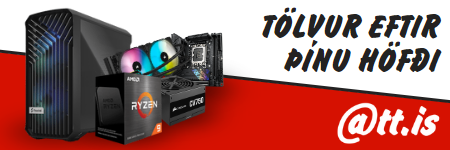Fartölva sem er búin að ganga non-stop í ca 8 ár er sennilega búin að gefa upp öndina.
Að því gefnu að HD sé í lagi, hver er auðveldasta leiðin til að komast í gögn?
Best væri, ef mögulegt er að tengja HD við aðra tölvu og ræsa hann sem sýndarvél. Er einhver leið að gera það?
Dauð fartölva - recovery
Re: Dauð fartölva - recovery
Taka HDD úr tölvunni og setja í flakkarabox eða dokku og tengja við aðra tölvu, kemur þá upp sem diskur í henni bara.
Aðaltölva: Dell Latitude 7480 | i7-7600u | 32GB DDR4 | 1TB SSD | 14"IPS
In-house streaming tölva: Ryzen 5600X | Gigabyte B550I Aorus Pro AX | 32GB 3600MHz | 1TB Samsung 980 Pro PCIe 4.0 | GTX960
Löglegt WinRAR leyfi
In-house streaming tölva: Ryzen 5600X | Gigabyte B550I Aorus Pro AX | 32GB 3600MHz | 1TB Samsung 980 Pro PCIe 4.0 | GTX960
Löglegt WinRAR leyfi
Re: Dauð fartölva - recovery
Er einhver sérstök ástæða fyrir því að þú vilt starta henni sem sýndavél? Er ekki nóg að komast í gögnin beint á disknum?
"Give what you can, take what you need."
Re: Dauð fartölva - recovery
Já, td er slatti af passwords í browser sem væri þægilegt að komast í.gnarr skrifaði:Er einhver sérstök ástæða fyrir því að þú vilt starta henni sem sýndavél? Er ekki nóg að komast í gögnin beint á disknum?
Re: Dauð fartölva - recovery
Veit ekki hvort þetti hjálpi en ég fann þetta á internetinu:
It’s fairly straight forward to do this. Because you have Windows 10 Pro, let’s use the free Hyper-V role that is built in.
Enable the Hyper-v role and configure an external virtual switch: https://blogs.technet.microsoft.com/can ... indows-10/
Use an external USB drive bay or USB to SATA adapter to hook your old drive up to your new computer. Or, if you’re adventurous just plug the old hard drive in to your new computer using a spare SATA port. The old drive should show up as one or more additional drive letters. Make a note of those drive letters.
Use Disk2VHD to convert all drives found in the previous step to a single VHDX file. Save the VHDX file anywhere that you have enough space to hold the file. It will be at least as big as the amount of space used on the old drive. Note: You can avoid booting issues later by making sure the System partition on the old drive is included in this step. If the System partition doesn’t show up in Disk2VHD, go in to Disk Management and assign a drive letter to the old System partition then try this step again.
Create a new generation 1 virtual machine in Hyper-V and when you are prompted to connect or create a virtual disk, use the option to connect an existing VHDX file and point it to the VHDX file you created earlier. Give the virtual machine at least 2GB of memory. https://docs.microsoft.com/en-us/virtua ... al-machine
Start your new virtual machine and connect to it and you will be using your old operating system. You do so from the Hyper-V management console.
You should install the virtual machine integration services so that your old operating system supports the features of the hyper-v environment.
https://docs.microsoft.com/en-us/window ... n-services
Note: If Windows fails to boot you’ll need to rebuild the boot records.
To do so, you’ll need to get in to a command prompt using Windows recovery environment. If Windows doesn’t boot automatically to the recovery environment, you’ll need to use a Windows 7 setup disc or .iso added to the virtual machine and boot from it. Now run the following commands at the command prompt.
bootrec /fixmbr
diskpart
select disk 0
list partition
select partition n (n is the Windows OS partition)
active
exit (to exit diskpart)
bootrec /fixboot
bootrec /rebuildbcd
exit
Now reboot the computer.
It’s fairly straight forward to do this. Because you have Windows 10 Pro, let’s use the free Hyper-V role that is built in.
Enable the Hyper-v role and configure an external virtual switch: https://blogs.technet.microsoft.com/can ... indows-10/
Use an external USB drive bay or USB to SATA adapter to hook your old drive up to your new computer. Or, if you’re adventurous just plug the old hard drive in to your new computer using a spare SATA port. The old drive should show up as one or more additional drive letters. Make a note of those drive letters.
Use Disk2VHD to convert all drives found in the previous step to a single VHDX file. Save the VHDX file anywhere that you have enough space to hold the file. It will be at least as big as the amount of space used on the old drive. Note: You can avoid booting issues later by making sure the System partition on the old drive is included in this step. If the System partition doesn’t show up in Disk2VHD, go in to Disk Management and assign a drive letter to the old System partition then try this step again.
Create a new generation 1 virtual machine in Hyper-V and when you are prompted to connect or create a virtual disk, use the option to connect an existing VHDX file and point it to the VHDX file you created earlier. Give the virtual machine at least 2GB of memory. https://docs.microsoft.com/en-us/virtua ... al-machine
Start your new virtual machine and connect to it and you will be using your old operating system. You do so from the Hyper-V management console.
You should install the virtual machine integration services so that your old operating system supports the features of the hyper-v environment.
https://docs.microsoft.com/en-us/window ... n-services
Note: If Windows fails to boot you’ll need to rebuild the boot records.
To do so, you’ll need to get in to a command prompt using Windows recovery environment. If Windows doesn’t boot automatically to the recovery environment, you’ll need to use a Windows 7 setup disc or .iso added to the virtual machine and boot from it. Now run the following commands at the command prompt.
bootrec /fixmbr
diskpart
select disk 0
list partition
select partition n (n is the Windows OS partition)
active
exit (to exit diskpart)
bootrec /fixboot
bootrec /rebuildbcd
exit
Now reboot the computer.
Re: Dauð fartölva - recovery
Setti bara diskinn í aðra tölvu!
w10 er furðu-duglegt að sækja drævera til að láta nýtt hardware virka...
w10 er furðu-duglegt að sækja drævera til að láta nýtt hardware virka...
-
Hjaltiatla
- Vaktari
- Póstar: 2671
- Skráði sig: Mið 07. Okt 2009 20:54
- Staðsetning: ::1
- Staða: Ótengdur
Re: Dauð fartölva - recovery
Þá þurfa Microsoft bara að fixa allt þetta telemetry rusl keyrandi í bakgrunninum á stýrikerfinu og hætta með þessi forced updates.Hizzman skrifaði: w10 er furðu-duglegt að sækja drævera til að láta nýtt hardware virka...
Gott mál að þú náðir að græja þetta samt sem áður.
Just do IT
√
√


